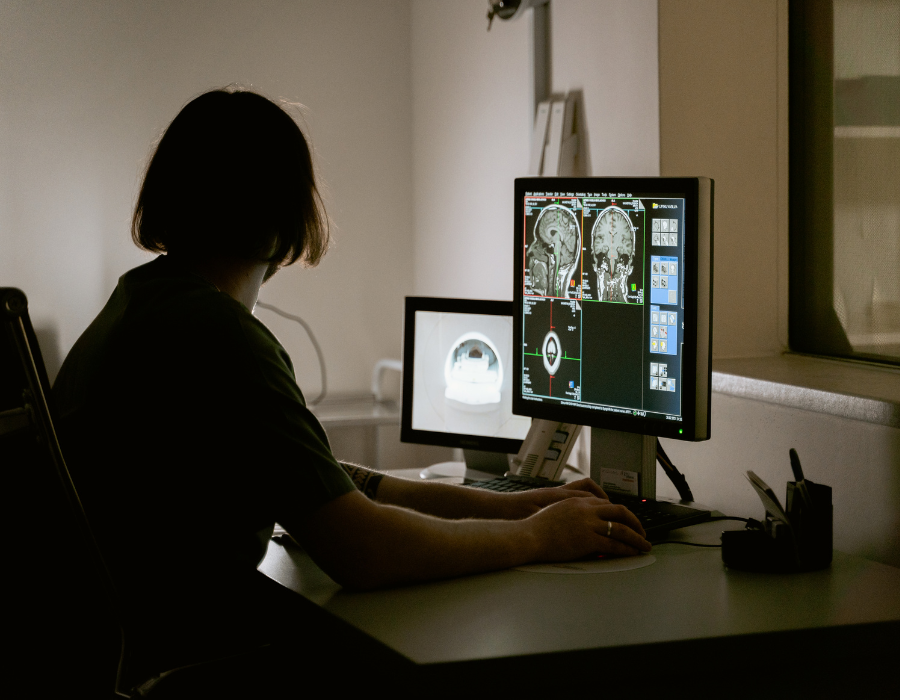As a radiologist, seeing injuries and lesions in patients every day is just part of the routine. But did you know medical imaging practitioners like you, especially when working remotely, are more likely to suffer from back and neck lesions due to working in non-ergonomic settings? That's why learning how to set up an ergonomic home office for radiologists is a topic worth discussing.
Due to the pandemic, many facilities and professionals made the switch to remote work and radiologists weren’t an exception. The healthcare system has adopted a hybrid model making it easier for patients to get an evaluation without having to go to the office in person.
By being a predominantly electronic work, diagnostic radiology is one of the clinical areas where practitioners have adopted at-home work most effectively, not only for work but also for educational purposes.
This sudden shift in the field has led to many facilities focusing on making this transition smooth for personnel by providing them with adequate equipment and tools to maintain productivity levels and ensure optimal performance.

A standard radiology setting
An example of this is the remote residency program launched by the University of Virginia Medical Center. They created workstations for radiology residents that included a PC tower, three monitors for viewing images and handling administration work, a keyboard, mouse PowerMic, webcam, and other accessories. They also preinstalled stations with access to the electronic health record, PACS, reporting systems, and virtual private network software.
After two months, the program showed a successful outcome, with residents expressing the change didn’t impact negatively on their productivity.
This result is not exclusive to educational settings. Successful results like these are also being experienced by working radiologists by not only increasing their productivity but also improving diagnostic accuracy, thanks to a more collaborative environment. This new way of working has enabled entire networks of radiologists to read studies from almost anywhere at home.
However, this switch to remote radiology has also uncovered new problems rooted in ergonomic mishaps leading to injuries.
Radiologists and back pain
Even though it is well known that the human body is not designed to sit on a chair in the same position for prolonged hours, this remains the primary cause for radiologists’ back pain.
As reported by Current Problems in Diagnostic Radiology, right now, radiologists are interpreting more studies per hour than they used to a decade ago. By spending at least 8 hours every day in front of the computer, they have also reported an increase in repetitive strain injuries (RSIs) that are affecting mainly the back, the neck, and the wrist.

In a pilot program of virtual ergonomics consults for remote radiology staff published in the Journal of the American College of Radiology, they reported that 40% of radiologists suffer from lower and upper back pain and 60% from neck discomfort.
This affects not only radiologists but also facilities due to the increased risk of injury and missed days from work. According to recent data from the US Bureau of Labor Statistics, 25% of musculoskeletal injuries requiring missed workdays occur in healthcare facilities.

Source: A Pilot Program of Virtual Ergonomics Consults for Radiology Staff Working From Home
Most of these issues, especially radiologists’ back pain, can be prevented or minimized if good ergonomic practices are implemented. Other problems related to poor ergonomics include visual problems, headaches, and other musculoskeletal problems.
How to set up an ergonomic home office for radiologists
The best way to escape from the common radiologists’ back pain is using prevention as the main strategy. Working remotely in an ergonomic space will help prevent injuries and improve productivity while maintaining optimal physical health.
Self-configuration of an ergonomic workstation at home is possible. Some of the aspects to keep in mind when creating a remote radiology office include lighting, furniture and seating, posture, and the arrangement of the equipment on the workstation.
Here are some tips on how to set up an ergonomic home office for radiologists:
Adequate lighting
An adequate workstation should have individual ambient lighting that meets the needs of the radiologist and doesn’t interfere with the brightness of the monitors by causing glare. The space should be illuminated well enough for the person using it to be able to read and write clearly.
Ergonomic monitors
This is one of the most important things when setting up an ergonomic home office for radiologists. Ideally, they should have three monitors: one ergonomic clinical review display to see the worklists and the others with high resolution and ergonomic features as well to review imaging.
The top of the monitor should be slightly above eye level to prevent them from hunching over and to minimize eye strain.
Keyboard and mouse placement
The placement of the keyboard and the mouse is vital. Their placement should be at a comfortable height with plenty of desk space to allow free movements.
It is preferable to have the keyboard at the edge of the desk allowing your wrists to have space to rest. Opting for a flat mouse could also help minimize wrist extension.
Adjustable and convertible desks
Height-adjustable furniture is the best option to help the radiologist avoid sitting in the same position for too long. There are also ergonomic desks that can convert into stand-up desks as well to make it easier to switch positions during the shift.
The ideal height for a desk will also depend on the chair the radiologist uses, but as a general rule, the elbow should be aligned with the elevation of the desk.
The right chair
An ergonomic chair for radiologists should have adjustable height and lumbar support to prevent lower back strain. It's also essential to include foot support as well, but if the chair doesn't include these features, a small ottoman or footrest stool can be used. Cushions are also a good option for lumbar support.
The chair's height must be adjusted so the forearms, wrists, and hands are leveled with the desk and keyboard. Otherwise, radiologists will strain their shoulders, neck, and back.
In the correct posture, radiologists should be in the back of the seat with 2-4 inches between the front of the chair and the back of their knees. Feet should be on the floor or have some form of support.

As we stated earlier, prevention is key to avoiding injuries and musculoskeletal problems, especially when it comes to remote radiology. It’s fundamental that radiologists keep in mind these basic recommendations to take care of their bodies.
Additionally, it’s important that facilities and healthcare centers provide them with the correct ergonomic equipment that supports their needs optimally, like ergonomic medical displays designed to provide comfort and productivity to their users, ergonomic furniture, and clear guidelines on how to properly create an ergonomic set up at home.

